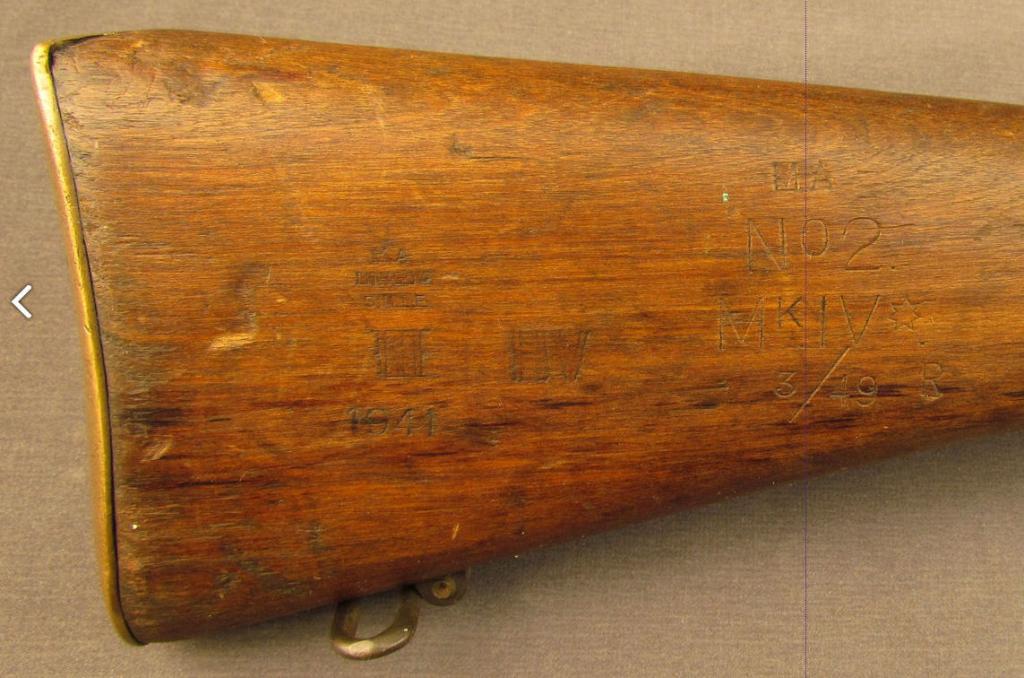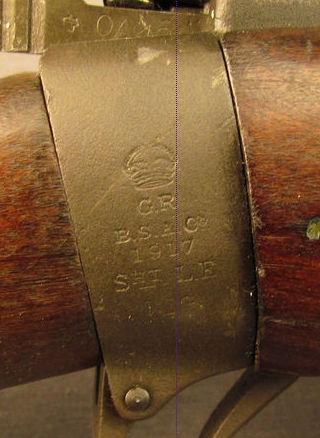-
Legacy Member

Hello And Question On A No. 2 Mk IV* .22 Trainer
Hello. New member here and this is my first post on this forum.
I recently purchased a No. 2 Mk IV* .22 trainer and would like a little help in deciphering its history.
The wrist of the receiver shows that it started life as a No. 1 Mk III* manufactured by B.S.A. in 1917. The left side of the buttstock describes the rifle as a Lithgow No. 1 Mk III dated 1941. The buttstock shows the rifle was converted at Lithgow to a No. 2 Mk IV* in 3/49. The conversion barrel has Lithgow proof marks and is dated 2/49.
My questions are these. How did this rifle end up in Australia after the end of WWI? Was it common for British
after the end of WWI? Was it common for British weapons to be transferred to other Commonwealth nations after the war? Does the 1941-dated Lithgow markings indicate the rifle was arsenal refurbished at that time?
weapons to be transferred to other Commonwealth nations after the war? Does the 1941-dated Lithgow markings indicate the rifle was arsenal refurbished at that time?
Here are all the other markings I've been able to find on the rifle plus a couple of photos.
Thank you for any information you may be able to provide.
Nose Cap: G over 52395, Crown over L2 over stylized B
Fore-end: G over 74756 over 52395, V, G
Rear Sight Assembly: WA '43
Barrel: 7 point star with A inside over I, 7 point star with A inside over II, 7 point star with A inside over III, Crown over 5 over L, MA over VI, MA over VII, 2 49, L over Broad Arrow over 1, Crown over Crossed Flags over P
Receiver: D with Broad Arrow inside, Crown over Crossed Flags over P, Crown over 16 over 13, 3 over 87934, G over 52395, Broad Arrow, AUSTRALIA, Crown over M5 over stylized B, stylized B, Crown over G.R. over B.S.A. Co over 1917 over SHT LE over III* (on wrist)
Breech Bolt: G 52395, Crossed Flags (on bolt handle)
Breech Bolt Head: 22 No 2, MA 49
Cocking Piece: 7 point star with A inside, OA '42
Trigger Guard: BA
Magazine: .22, 7 point star with A inside over 3, 3
Magazine Catch: Broad Arrow
Trigger: 7 point star with A inside, BA
Safety Lever: III, FA
Buttstock: M.A. over LITHGOW over S.M.L.E. over III over 1941, HV, MA over No 2 over Mk IV * over 3 / 49 R, 9 / 44 (on left side), '41, 3 over Crown over 11 over L (on underside)
Butt Sling Swivel: MA
Buttplate: MA



Information
 |
Warning: This is a relatively older thread
This discussion is older than 360 days. Some information contained in it may no longer be current. |
|
-
-
03-06-2016 08:28 AM
# ADS
Friends and Sponsors

-
-
-
-
Legacy Member

Thank you very much for your reply, Peter. I suspected as much, but it's nice to have confirmation.
P.S.- My first car was a black 1960 MGA which I bought for $600. 
Steve
NJ State Trooper #3936 (retired 4-1-1991)
NRA LE Firearms Instructor
-
-
I bet you wish you still had that MGA now............
-
-
Legacy Member

I bet you wish you still had that MGA now............
Very much so!
Steve
NJ State Trooper #3936 (retired 4-1-1991)
NRA LE Firearms Instructor
-
-
Legacy Member

I seem to recall that the UK sent something like 30,000 British rifles to Australia right after WW I to compensate Australia for the 30,000 they sent to the UK in 1914/15.
rifles to Australia right after WW I to compensate Australia for the 30,000 they sent to the UK in 1914/15.
I have seen a lot of these rifles redone in Australian service, all seem to date from the WWII period.
service, all seem to date from the WWII period.
Forget where I read that but there was a reference to this in some book on the Enfield.
-
-
Legacy Member


Originally Posted by
Frederick303

I seem to recall that the UK sent something like 30,000
British
rifles to Australia right after WW I to compensate Australia for the 30,000 they sent to the UK in 1914/15.
I have seen a lot of these rifles redone in
Australian
service, all seem to date from the WWII period.
Forget where I read that but there was a reference to this in some book on the Enfield.
That's very interesting, Frederick303. Thanks a bunch for the information!
Steve
NJ State Trooper #3936 (retired 4-1-1991)
NRA LE Firearms Instructor
-
-
Legacy Member

So I did a wee bit more checking of my books on the subject and here is what I found below. Not saying this is in any way complete, but might explain some of the facts associated with the late UK SMLE rifles that show up in Australian guise:
guise:
1) State issue numbers indicate around 22,000 SMLE rifles were on issue prior to June 1910, which means around 22,000 UK rifles would have been imported into Australia prior to that time (Lithgow did not start production until 1913)
2) The number of English SMLE rifles imported to Australia between July 1910 and August 1914 was no less than 50,445, which represents all of the Federal orders put in with the British war office after July of 1910.
war office after July of 1910.
3) In August of 1914 the Australian Federation had orders for 17,500 rifles on order with UK, all of which were requisitioned by the UK government, none went to Australia
4) Lithgow production by the summer of 1914 had reached 4,760 rifles total:
5) between June of 1914 and June 30th of 1915 the total rifles produced in Australia were 13,800.
6) Between June and October of 1915 the Production at Lithgow added another 10,800 rifles. By December of 1915 another ~5400 rifles were added.
7)The total rifles on hand in Australia as of October 1915 should have been 101,805 rifles, with another 5,400 added by the end of the year.
8) The Australian Government sent over all replacements up until October 1915 with SMLE rifles, after October 1915 the UK took over responsibility for arming them.
9) In December 1915 the total number of SMLE rifles in Australia was around 10,000, the rest having been shipped overseas with the 120,000 troops. That would imply Australia sent over something like 95,000 rifles.
10) All of the rifles shipped were sighted for MK IV ball. As such expect for those rifles sent to the middle east, and Gallipoli, all of the rifles on the western front were changed out of Australian hands and replaced with MKVII sighted rifles.
11) The exact number of rifles owed to Australia I could not find, but when the Australian troops returned form the war in 1918, all of the troops on the western front would have been equipped with UK made rifles form the joint weapons pools. In 1918 the strength of the AIF in France was no less than 117,000 in 5 divisions in 2 corps. It is hard to see the numbers of rifles returned to Australia falling below 70,000 UK rifles (14,000 per division).
was no less than 117,000 in 5 divisions in 2 corps. It is hard to see the numbers of rifles returned to Australia falling below 70,000 UK rifles (14,000 per division).
12) When WWII started Australia sent something like sent 30,000rifles over to the UK, as well as supplying their divisions with all small arms required (other than sub machineguns up until 1942)
13) In WWII all small arms were pooled in theaters, so the Australian units in North Africa and Italy would have seen their arms gradually replaced somewhat with UK rifles, all of which would have mostly been WWI rifles.
would have seen their arms gradually replaced somewhat with UK rifles, all of which would have mostly been WWI rifles.
14) After WWII large numbers of the returning rifles were FTRed in one manner or another.
15) So a UK made rifle that was FTR ed in Australia post WWII could have been a pre WWI rifle from the 10,000 retained in 1915, one of the UK rifles returned with the AIF in 1918/1919 or a WWII pooled rifle.
-
The Following 3 Members Say Thank You to Frederick303 For This Useful Post:
-
Legacy Member

Thank you VERY much for taking the time to research this for me, Frederick303! I greatly appreciate the effort and information, partner!
I printed out your info and will keep it with my other research material.
Steve
NJ State Trooper #3936 (retired 4-1-1991)
NRA LE Firearms Instructor
-
after the end of WWI? Was it common for British
weapons to be transferred to other Commonwealth nations after the war? Does the 1941-dated Lithgow markings indicate the rifle was arsenal refurbished at that time?

 Information
Information















 PM
PM












